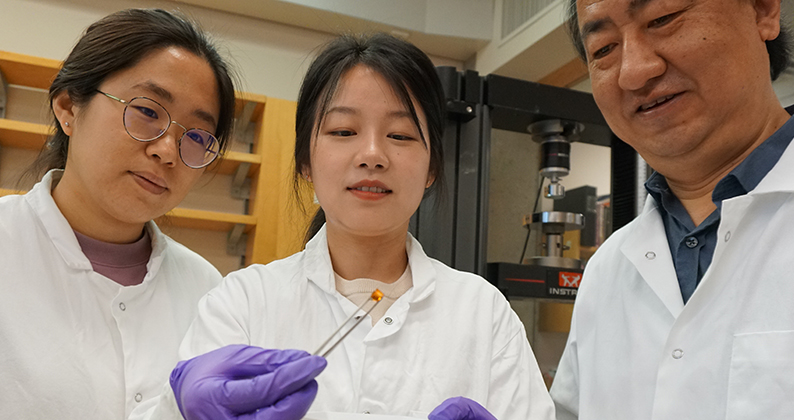
Researchers at the University of British Columbia have developed a biodegradable hydrogel implant that addresses the inherent challenge of regenerating cartilage in injured joints.
Regenerating articular cartilage using biodegradable scaffolds requires matching the opposing properties of stiffness and toughness found in natural cartilage. That’s not easy to do.
“Cartilage is tricky,” said Hongbin Li, Ph.D., a professor in the Department of Chemistry at the University of British Columbia. “Articular cartilage repair is an important medical challenge because naturally speaking, it doesn’t repair itself.”
Dr. Li said that engineering stiff and tough protein hydrogels is not only difficult in material science and engineering, but also represents an unmet clinical need for biomedical applications that require stiff and tough matrices. “Cartilage is one such example,” he added.
His research group has been working on the development of protein-based hydrogels for more than a decade and finally found a way to effectively regenerate cartilage. The gel they developed is tougher and stiffer than other protein hydrogels, resists compression and regains its shape as well as natural articular cartilage. It’s a promising discovery that has the potential to transform the treatment of joint injuries.
Determining the Right Combination
Dr. Li pioneered the use of elastomeric proteins made of folded globular domains to engineer protein hydrogels with tailored mechanical properties. “These gels effectively dissipate energy at high strain and recover after deformation through the force-induced unfolding and refolding of folded globular protein domains,” he said.
The initial gels were suitable for mimicking soft tissues such as muscle, but weren’t a match for stiff tissues like cartilage.
Stiff implants maintain their shape, but are more likely to break when bent. Implants that are tough are less likely to break, but might be too soft to use in a joint. With these challenges in mind, Dr. Li’s team developed strategies to enhance the stiffness of protein hydrogels without compromising their toughness.
The researchers published details about the process in the journal Nature. They noted that introducing chain entanglement into the hydrogel network made of folded elastomeric proteins resulted in highly stiff and tough protein hydrogels. These hydrogels seamlessly combine mutually incompatible mechanical properties to convert soft protein biomaterials into stiff and tough materials, which exhibit mechanical properties that resemble those of natural cartilage.
Muscle achieves its toughness through finely controlled forced domain unfolding and refolding in the muscle protein titin, noted the researchers. They said articular cartilage achieves its stiffness and toughness through an entangled network comprising collagen and proteoglycans.
“These entangled chains can move, which allows energy, for instance, the impact from jumping, to be dissipated, just like shock absorbers in bikes,” said study first author Linglan Fu, Ph.D. “We combined this feature with an existing method of folding and unfolding proteins, which also allows for energy dissipation.”
Advancements in protein mechanics and engineering have made it possible to engineer elastomeric proteins and soft protein biomaterials that mimic the passive elasticity of muscle, noted the researchers. They found a way to do the same for cartilage.
“The unique feature of our strategy is the combination of biodegradability, biomechanical and biochemical compatibility in one hydrogel that can be used as an implant for repairing osteochondral defects,” Dr. Li said. “This combination is missing in most previous efforts, with biomechanical incompatibility as one of the main issues.”
After implantation in rabbits, the hydrogel demonstrated notable levels of articulation repair and bone tissue growth that resembles existing cartilage at 12 weeks.
The researchers noted that a stiffer version of the gel outperformed a softer version. They believed the stiffer gel was more compatible with natural bone and cartilage tissue, cueing the body to regenerate cartilage. Dr. Li said studies have shown that biomechanical cues, like biochemical cues, are of critical importance to the successful regeneration of cartilage.
“Our work has demonstrated a promising methodology in engineering protein hydrogel implants that can provide a biomechanically more compatible environment for the regeneration of cartilage and osteochondral bone,” he added.
The researchers were surprised that further increasing the stiffness of the hydrogel worsened the repair outcome, likely because the much higher stiffness resulted in the much slower degradation of the hydrogel implant in the body.
“This finding demonstrates the complexity of cartilage regeneration and repair and highlights the need to consider biomechanical cues, as well as biochemical and biophysical factors when designing hydrogel scaffolds,” Dr. Li said. “It’s critical to simultaneously optimize biomechanical, biochemical and biophysical factors to provide a suitable microenvironment for the regeneration of cartilage.”
Fine-tuning the Cues
Dr. Li and his colleagues discovered a general blueprint for engineering protein-based biomaterials that are stiff and tough. He wants to use the finding to provide a practical solution for cartilage regeneration, which remains a major clinical need in orthopedics.
“Our work demonstrated the necessity and critical importance of optimizing biomechanical cues in the design of hydrogel implants for cartilage repair,” he said. “More work is needed to further improve the hydrogel design and their efficacy.”
Dr. Li noted that this work may include the incorporation of biochemical cues, such as growth factors, fine-tuning the protein hydrogels and animal studies to evaluate the long-term efficacy of applying the gels to cartilage repair.
“By optimizing biochemical and biomechanical cues together,” he said, “we will see in the future whether these new scaffolds can lead to even better outcomes.”
DC
Dan Cook is a Senior Editor at ORTHOWORLD. He develops content focused on important industry trends, top thought leaders and innovative technologies.




